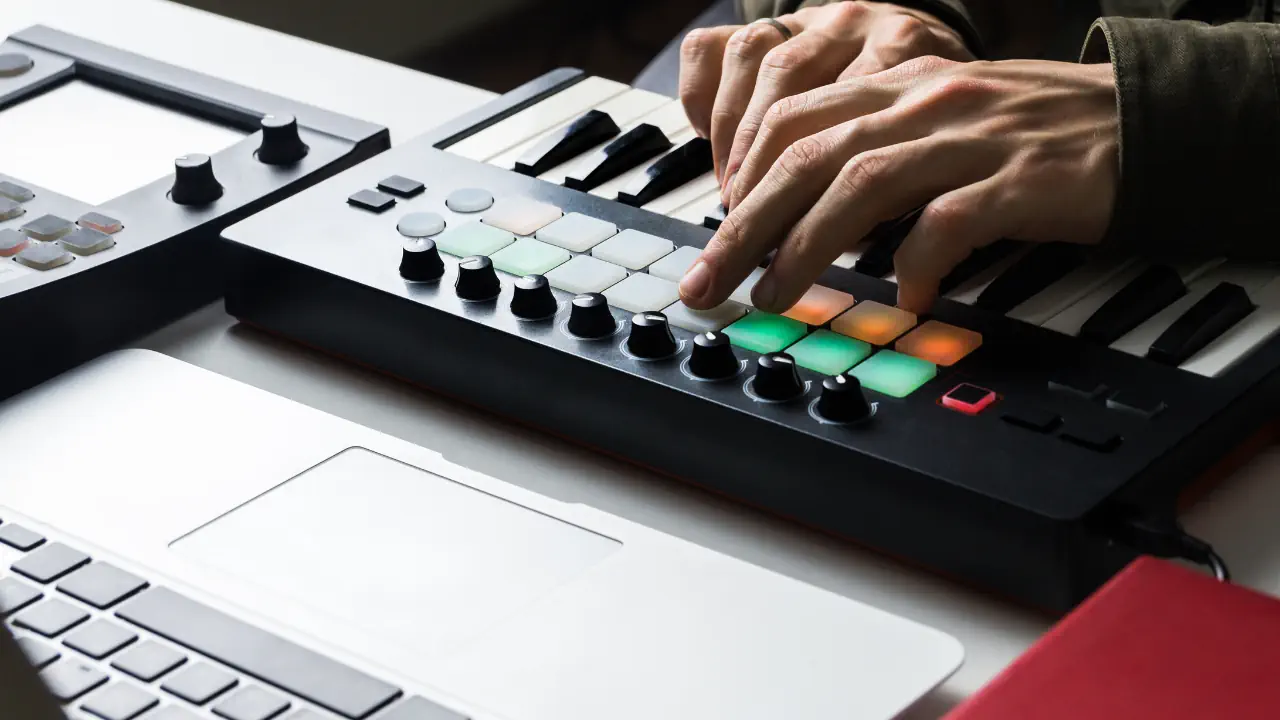
The Music production basic to produce music is a fascinating and intricate process.
Ever wondered how your favorite song evolves from a simple melody in an artist’s mind to a chart-topping hit?
Exploring music production is an exciting journey of creativity and technical skill.
Knowing these 5 stages can help you make great music if you want to be a musician.
In this article, I will explain each phase. It will help you make a roadmap for your music projects in your home studio.
Introduction to Music Production
What is Music Production?
Music production is the whole process of creating music, from start to finish.
Music production includes composing, arranging, sound design, recording, mixing, and mastering. Each stage plays a role in shaping the sound and quality of the music.
Role of a Music Producer
Every music producer is the mastermind behind the entire production process.
Artists, engineers, and musicians receive help with creative and technical aspects of production.
The music producer helps artists succeed. They also ensure the final product matches their vision.
The 5 Stages of The Music Production Process
Stage 1: Composition
The first stage is composition. This is where the magic starts. The composer creates musical ideas and builds the song’s base.
The composer creates a catchy melody with exciting chords and captivating song structures.
Then, the composer tries out different musical ideas like melodies, harmonies, and rhythms.
They may also explore different emotional themes or vibes they want the song to convey.
A catchy tune grabs your attention and makes the music enjoyable and easy to remember.
The composer tries melodies, intervals, phrasing, and dynamics to capture the mood.
Progressions play a significant role in creating the harmonic foundation of the composition.
The composer can try different combinations to create exciting progressions. Exploring tones and voicings can do this.
A well-written passage can make you feel different emotions and add depth to the music.
Also, besides melody and progressions, the composer focuses on constructing captivating structures.
To create a song, you must decide on the parts, like verses, choruses, and bridges. You also have to arrange these parts in a particular order.
The composer can experiment with different variations of these sections. This builds tension, adds dynamics, and makes the music more interesting.
When composing, develop and improve ideas to create a solid foundation.
Themes, progressions, and structures engage and connect with audiences. You need creativity, experimentation, and skill to achieve this.
Stage 2: Arrangement
Once the composition is complete, the next stage is the arrangement.
The producer uses various elements and sounds to improve ideas and complete a song. The goal is to ensure that the arrangement flows and holds the listener’s attention.
The producer determines the structure and makes necessary changes during the arrangement stage.
They’ll try different instruments and textures to make the composition sound better.
The arrangement should have a logical progression. The progression of each section transitions into the next.
Maintaining their attention is essential to keep the listener interested in the song. To prevent boredom, you can change the volume, instruments, or themes during the music.
The producer might try new things to make certain parts of the composition better.
Make unique sounds using different instruments, harmonies, effects, or techniques.
During the arrangement stage, the goal is to make the song come alive and resonate with the listener.
The producer can create a compelling arrangement by developing and organizing the ideas. This arrangement captures the essence of the song and makes a lasting impression.
Stage 3: Sound Design (Shaping) and Production
The third stage is sound shaping and production. This stage is where the producer focuses on the sonic aspects of the song.
Musicians select and alter sounds to make varied textures and effects in their music.
The aim is to make the song sound great on various systems so the listener feels engaged.
At this stage, we make the sounds better by adjusting them, making them smoother, and adding echo to mix them.
The producer can make the song sound deeper and more spacious. They can use techniques like panning and stereo imaging.
During this stage, the producer may also enhance the song’s dynamics.
Enhancing the dynamics means changing the volume of different parts. This volume change will make some dynamics stand out, and others blend in.
The producer can add more parts to the song to make some parts better or create a particular mood.
This mood could include adding background vocals, instrumentation, or sound effects. Musicians use hardware and software synthesizers (midi synth) in electronic music production.
The producer can experiment with spatial effects. Some include widening the sound or adding movement.
These effects can make the song more engaging and dynamic.
The producer listens to the song with headphones, car speakers, and studio monitors. They want to make sure the mix sounds good on all platforms.
No matter what kind of audio equipment you use, adjusting it can make the song sound better.
By the end of this stage, the producer should have a polished and professional finished mix.
Once they finish the earlier stages, they can focus on perfecting the song for release.
Stage 4: Mixing

The music enters the mixing stage after the sound shaping and production.
In this stage, they balance, polish, and fine-tune every element of the song. This balance will create a cohesive and professional stereo mix.
The producer improves each element by using EQ, compression, and stereo-imaging. The goal is to create a balanced and pleasing sonic experience for the listener.
During mixing, the producer adjusts track levels. These adjustments make them audible and blend.
Use faders to adjust the volume of voices, instruments, and other tracks. After that, the producer uses equalization (EQ) to adjust each track’s frequency.
EQ boosts or cuts specific frequencies. For example, the bass in a drum track or reducing the high frequencies.
These boots or cuts help to enhance the clarity and tonal balance of the mix. Compression is another important tool used during this stage.
To control the range of each track, lower the volume of loud parts and raise the volume of softer parts.
Volume control keeps the sound consistent and polished. This is so nothing stands out or gets lost.
Producers also use stereo-imaging techniques to make the mix feel spacious and dimensional.
To grasp width and depth, you shift elements across the sound image field and place them.
You can also apply other effects, such as reverb and delay, to add space and ambiance to the mix.
When mixing, the producer listens and makes changes to get the right sound balance.
They ensure no element is more important than another. This balance creates a captivating mix.
The ultimate goal of mixing is to create a balanced and pleasing sonic experience.
A well-mixed song will have clarity, depth, and impact. Where we hear and appreciate each element.
The producer uses various methods and tools to emphasize the best qualities of each part. They aim to make a final mix that reflects the music’s vision and intention.
Stage 5: Mastering
The final step before distribution involves mastering. In the post-production process, the mastering engineer prepares the music for distribution.
The mastering engineer adds the final touches to the mix. Doing so ensures it sounds good on different systems and meets industry standards.
The aim is to make the song sound good and balanced for radio and streaming platforms. To improve a song, fix issues, clarify the instruments, and balance the volume.
The engineer may also apply reverb or stereo-widening effects to improve the sound. The engineer listens to the track changes to ensure it sounds smooth and consistent.
They also decide the order of songs on an album, creating the final track sequencing.
The engineer exports the music as high-quality audio files like WAV or FLAC. You can use these files in many ways, like copying, sharing, or using different formats.
It is important to note that mastering is not a magic fix for a mixed song. The engineer can enhance the music when the tracks are well-mixed.
The final product needs to sound good and meet industry standards for release.
Critical Terms in Production
Music Production Process
Creating a song involves many stages, from composing to mastering.
Music Producer
A producer is the creative and technical mastermind behind the production process. They manage everything from guiding artists to shaping the final sound.
Stages of Production
Music production involves various stages in creating and refining a piece of music.
These stages include composition, arrangement, sound shaping, production, mixing, and mastering.
Sound Shaping
Sound shaping is creating and manipulating sounds to achieve a desired sonic result. To make the composition sound better, you choose and arrange different elements.
Songwriting
Songwriting involves creating lyrics, melodies, and chord progressions that build a structure. It is an essential part of the music production process.
Music production for beginners
Newcomers use technology and instruments to create, arrange, and manage music.
You’ll need to understand sound waves and use DAW tools to arrange and mix sounds to learn this.
If you want to be a producer, it’s essential to understand rhythm, harmony, and theme in music.
To succeed in production, you must be creative and patient to make the final piece right.
Conclusion: Music Production Basic
Recap of the Stages of the music
Music production comprises five stages. Those stages are composition, arrangement, sound shaping and presentation, mixing, and post-production.
Each step plays an essential role in shaping and refining the final product.
Music theory is essential when creating compositions, along with production and recording.
Importance of Each Stage in Creating Music
Every stage in the music production process is essential for creating high-quality music.
The process influences the composition’s sound, from ideas to final details.
Continued Learning and Improvement in Music Production
Music production is an ongoing learning process. Aspiring music producers should strive to develop their music production techniques and skills.
